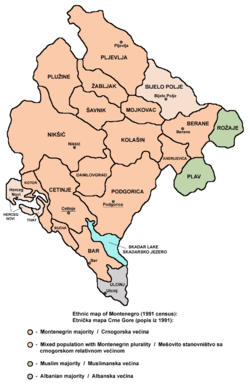Demographic history of Montenegro: Difference between revisions
correct link , Replaced: [[WWII → [[World War II using AWB |
|||
| Line 179: | Line 179: | ||
* [http://www.njegos.org/census/index.htm Montenegrin Census' from 1909 to 2003] |
* [http://www.njegos.org/census/index.htm Montenegrin Census' from 1909 to 2003] |
||
* [http://www.rastko.org.yu/istorija/srbi-balkan/vrudic-montenegro.html The Ethnic Structure of the Population in Montenegro] |
* [http://www.rastko.org.yu/istorija/srbi-balkan/vrudic-montenegro.html The Ethnic Structure of the Population in Montenegro] |
||
* "Petar I Petrovic' - DJELA" publisher CID Podgorica 1999 year, printed by "Vojna tamparija" - Beograd |
|||
[[Category:History of Montenegro]] |
[[Category:History of Montenegro]] |
||
Revision as of 06:44, 23 November 2006


This article presents the demographic history of Montenegro through census results and official documents which mention demographic composition. See Demographics of Montenegro for a more detailed overview of the current demographics of Montegro.
1855
According to the Code of Prince Danilo Petrović Njegoš from 1855, the Montenegrin populations' ethnicity is Serbian and the religion is Eastern Orthodoxy (Christianity).
1882
Schwartz estimated in 1882 that the Princedom of Montenegro had 160,000 inhabitants. Although, a more usual estimate is that it was around 230,000 inhabitants.
1895-1899
According to the Geography of the Princedom of Montenegro published in 1895-1899, all inhabitants of Montenegro were Serbs, mostly of Orthodox faith - although there were some Roman Catholics and Muslims.
1900
In 1900, according to international sources, the Principality of Montengro had 311,564 inhabitants. By religion:
- 293,527 Eastern Orthodox (94,21%)
- 12,493 Muslims (4,01%)
- 5,544 Roman Catholic (1,78%)
By litteracy:
- 77% illiterate
- 71,528 (23%) literate
The Princedom had around 5,000 Albanians and a colony of 800 Romas.
1905
This year there were 6,674 emigrants, mostly to the United States.
1906
This year there were 4,346 emigrants, mostly to the United States.
1907
It has been estimated that there were around 282,000 inhabitants in Montenegro this year.
1909
The 1909 official census was undertaken by the authorities of the Principality of Montenegro. Ethnicity was decided according to the mother tongue, the official language then being the Serbian language:
Total: 317,856 inhabitants. By language:
By religion:
- Orthodox Christians: 94.38%
- others (mostly Muslims)
The total population was overestimated for political reasons .It was at about 220,000 inhabitants.
1914
The Cetinje government state in the Code of Law in 1914 that there are around 500,000 citizens of Montenegro. It was defined that the Montenegrin people can be only referred to all citizens of the Kingdom of Montenegro, since a Montenegrin ethnicity doesn't exist and Montenegrins are ethnic Serbs.
1921
In 1918 Montenegro entered the Kingdom of Serbs, Croats and Slovenes. In 1921 it organised a census which recorded the mother tongue and religion. A category called Serbian or Croatian was to include all respondents who termed their mother tongue as Serbian. In the counties Andrijevica, Bar, Kolasin, Niksic, Podgorica and Cetinje, which are categorized in official statistics as Montenegro, there were:
Total: 199,227 inhabitants Serbs: 181,989 (91.35%) Albanian: 16,838 (8.45%)
The counties Berane and Bijelo Polje, which are today in Montenegro, were considered counties of Old Serbia:
Berane, total 23,864 inhabitants, Serbs 23,561 or (98.73%) Bijelo Polje, total 26,147 inhabitants, Serbs 26,136 (99.96%)
Summed results:
Total: 249,238 inhabitants Serbs: 231,686 (92.96%) others mostly Albanians
1931
The 1931 census was also taken by the Kingdom of Yugoslavia but was later processed in Communist Yugoslavia. Results within today's borders of Montenegro were:
Total: 360,044 inhabitants :Orthodox: 272,702 (80.88%) :Roman Catholics: 26,070 (7.24%) :Muslims 61,038 (16.96%)
:Serbian, Croatian, Slovenian and Macedonian language: 339,955 (90.13%) :Albanian language: 18,098 (5.03%)
1948
In 1945, after World War II, Communist Yugoslavia was formed, and Montenegro was proclaimed as one of its constituent republics. The 1948 and following censa were taken by the Republic of Montenegro.
Total: 377,189 inhabitants :Montenegrins: 342,009 (90.67%) :Albanians: 19,425 or (5.15%) :Croats: 6,808 or (1.8%) :Serbs: 6,707 or (1.78%)
Practically all people who have in former censa declared themselves as having Serbian mother tongue were now declared as Montenegrins.
1953
The 1953 census results:
Total: 419,873 inhabitants :Montenegrins: 363,686 (86.62%) :Albanians: 23,460 (5.58%) :Serbs: 13,864 (3.3%) :Croats: 9,814 (2.34%) :Yugoslavs: 6,424 (1.53%)
This census witnesses the forming of the Yugoslav nation.
1961
The 1961 census results:
Total: 471,894 inhabitants :Montenegrins: 383,988 (81.37%) :Muslims: 30,665 (6.5%) :Albanians: 25,803 (5.47%) :Serbs: 14,087 (2.99%) :Croats: 10,664 (2.26%) :Yugoslavs: 1,559 (0.33%)
In 1968 the Communist Yugoslav government introduced a new category, Muslims by nationality.
1971
The 1971 census results:
Total 529,604 inhabitants :Montenegrins: 355,632 (67.15%) :Muslims: 70,236 (13.26%) :Serbs: 39,512 or (7.46%) :Albanians: 35,671 (6.74%) :Yugoslavs: 10,943 (2.07%) :Croats: 9,192 (1.74%)
1981
The 1981 census results:
Total: 584,310 inhabitants :Montenegrins: 400,488 (68.54%) :Muslims: 78,080 (13.36%) :Albanians: 37,735 (6.46%) :Yugoslavs: 33,146 (5.67%) :Serbs: 19,407 (3.32%) :Croats: 6,904 (1.81%)
1991
The 1991 census results:
Total: 615,035 inhabitants :Montenegrins: 380,467 (61.86%) :Muslims: 89,614 (14.57%) :Serbs: 57,453 (9.34%) :Albanians: 40,415 (6.57%) :Yugoslavs: 26,159 (4.25%) :Croats: 6,244 (1.02%)
2003
The 2003 census was undertaken by authorities in Montenegro, which at this time, together with Serbia, constituted Serbia and Montenegro.
Initial data:
Total: 672,656 inhabitants :Montenegrins: 273,366 or (40.64%) :Serbs: 201,892 or (30.01%) :Bosniaks: 63,272 (9.41%) :Albanians: 47,682 (7.09%) :Muslims: 28,714 (4.27%) :Croats: 7,062 (1.05%)
Corrected data:
Total: 620,145 :Montenegrins 267,669 (43.16%) :Serbs 198,414 (31.99%) :Bosniaks 48,184 (7.77%) :Albanians 31,163 (5.03%) :Muslims 24,625 (3.97%) :Croats 6,811 (1.10%) :Roma 2,601 (0.42%)
This census witnessed the forming of the Bosniak nation; quite a few people still thought of themselves Muslims by nationality, however. Also, there are very few people left who consider themselves Yugoslavs. But the biggest difference with 1991 census is the unparalleled increase in the number of Serbs.
Sources
- Montenegrin Census' from 1909 to 2003
- The Ethnic Structure of the Population in Montenegro
- "Petar I Petrovic' - DJELA" publisher CID Podgorica 1999 year, printed by "Vojna tamparija" - Beograd
